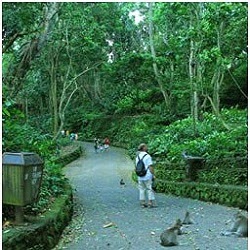History of Ubud Monkey Forest at Ubud Village
UBUD MONKEY FOREST
UBUD MONKEY FOREST IS A NATURE RESERVE AND TEMPLE COMPLEX IN UBUD VILLAGE ALSO AS A PLACE OF SCARED MONKEY FOREST SANCTUARY
The Wanara Wana
It is important to treat the monkeys with respect as this forest is heir home and you are a guest in it. Please remain on the paved paths. The monkeys may become aggressive if you invade their private areas ( wanara Wana staff and researcher may occasionally be seen in this areas please do not follow them.
It can often seen how the Balinese Macaques are cracking open coconuts. If available they like to eat bananas and papayas, too. Once taken please leave the fruit with the monkeys. If you with to feed the macaques please do so carefully, and if they take food from you, please do not attempt to retrieve it back. It is also of great importance that you treat the trees, the plants and other animals and structures within the Sacred Monkey Forest with great respect.
This is holy area and an important ecological preservation. please enjoy the beauty and magic of this place. while at the same time respecting what lives in it. If you have any question or if you should need assistance, please asked the Wenara wana personnel ( identified by their green uniforms ) or a member of the research project.
- The Gods bless life and created nature and all of its entities
- Nature provide sustainable support to the need of living beings
- Human beings as the highest being has the obligation to preserve the mother nature which was in the past only religious approach could operate before more reasons could take over the role.
- Pura Dalem Agung, located at the south western corner of the main forest area. This temple is the most prominent in Monkey Forest
- The Holy Bathing Temple located down steps close to the water stream. This temple is divided into 3 courtyards ( mandalas ) with pools.
- The Prajapati temple with cemetery located at the southernmost of the area.
About 300 macaques currently reside in the monkey forest. There are approximately 35 adults males, 95 adult females and 170 young. These macaques live primarily in three clusters of females and males. Each of these groups tends to use different areas of the forest at different ties of the day. All macaques use all of the forest. Conflicts sometimes arises when two groups are in same area. Adult males weight up to 8 to 10 kgs and have large canines teeth, broad shoulders and facial hair that resembles a mustache. The adult females are smaller then the males ( 4-8 kgs ) and have long facial hair resembling beads. Balinese macaques group is centered around groups of related females called "matriline" Male macaques usually migrate in from other area and attempt to associate themselves with the female matriline Both males and females, have st of dominance relationship, but they are not always clear or consistent.
Mating can take place all year round but most infants are born during the months of May - August. Macaques mothers range from very protective to very permissive with their infants. Many females who are not the mother spend time holding and caring for infants. Sometimes you will even see an adult male "mothering" as well.
Research and Conservation Ubud Monkey Forest
The Sacred Monkey Forest serves not only as an important component in the spiritual and daily life of the villagers, but is the site of several research and conservation programs. The maintenance and management of special place like this attract the attention of researchers from all over the world, especially the interaction between human beings and the monkeys of this sacred place are subject to surveys and research studies.
Source : Ubud Monkey Forest
Author : Bali Golden Tour







